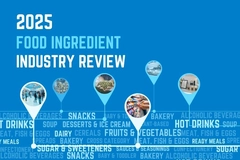
- Industry news
Industry news
- Category news
Category news
- Reports
- Key trends
- Multimedia
Multimedia
- Journal
- Events
- Suppliers
- Home
- Industry news
Industry news
- Category news
Category news
- Reports
- Key trends
- Multimedia
Multimedia
- Events
- Suppliers
Picture-perfect tints: Age of Instagram strengthens natural coloring offerings

10 Dec 2019 --- The rise of social media and consumers’ increasing interest for clean label products have created the perfect storm for the proliferation of the natural colors trend. Platforms such as Instagram have given the appearance – specifically color – of food extra gravity and industry is making strides to optimize their offerings targeting planet-aware consumers living and eating in an “Instagrammable” world. FoodIngredientsFirst takes a closer look at the latest innovations in the natural color arena.
“The biggest change in the last five years has been the new role of social media in the food environment. Having healthy food that contains natural, recognizable and trusty ingredients remains a key driver for food developers. This continues to be true, but today’s consumers are now looking to share appealing food and new experiences on social media,” says Nathalie Pauleau, Global Product Manager of Colours at Naturex, which is part of Givaudan.

She adds that to answer this demand, the food industry is using natural colors and coloring foods as a new vector of innovation, developing colorful products that deliver new experiences through a holistic approach with taste, color and wellness attributes.
This is also the case at GNT Group, with Maartje Hendrickx, Market Development Manager, noting that the use of social media platforms such as Instagram has led consumers to seek more adventurous choices. This has also led to a shift of sensory emphasis. “Now, it is not so much about the taste, but it is much more about the color and the look and feel of the products we see on social media platforms,” she adds.
Pat Hanson, Managing Director of Food Colors EMEA at Sensient, agrees that the visual appeal of food and drink products is growing in popularity due to a social media sharing-based culture. “Consumers are no longer satisfied with simply buying products. Increasingly, they want brands to provide experiences like different or intense color hues.”
According to Innova Market Insights, the use of natural colors in food and beverage launches has increased globally, featuring a 6 percent year-over-year growth when comparing 2018 and 2017 launches. In 2018, the top categories of global product launches tracked with natural colors were bakery (14 percent), confectionery (14 percent) and snacks (11 percent), with caramel color being the leading ingredient among the natural colors tracked.
.jpg) The visual appeal of food and drink products is growing in popularity due to a social media.DDW has a long history – over a century – of creating natural caramel colors, with Connie Sandusky, Global Marketing Director, bringing attention to brown also being a color. However, she is excited to see the color-house expand into different colors following its July acquisition of DuPont Nutrition & Bioscience’s natural color business.
The visual appeal of food and drink products is growing in popularity due to a social media.DDW has a long history – over a century – of creating natural caramel colors, with Connie Sandusky, Global Marketing Director, bringing attention to brown also being a color. However, she is excited to see the color-house expand into different colors following its July acquisition of DuPont Nutrition & Bioscience’s natural color business.
Telling the sustainability story
DDW recently launched a red color, produced from a traditionally-bred corn hybrid. “It has a strong farm-to-fork story that is fully traceable and results in a bright red with a wide range of applications. Because we developed and grow the corn hybrid, we can trace it to the farmer, ultimately delivering a product with a responsible story to the end-consumer,” explains Sandusky. This desire for storytelling was recently crowned Innova Market Insight’s top trend for 2020.
Interwoven with the storytelling trend is the rise of sustainability, with consumers seeking transparency. “A transparent supply chain helps manufacturers ensure the quality and safety of what they are producing and create premium brand positioning,” explains Sandusky.
She adds that the other aspect of transparency is around the intended purpose of using an ingredient. While “dual-use” ingredients are an evolving regulatory story in Europe, its origins are consumer-based. “Consumers want to know where their food comes from, what’s in it, and why it’s in there.”
Hanson also highlights Europe as an interesting market in this space, explaining that as natural color usage is so highly saturated there, companies are now seeking out coloring foods to even better align with European consumers’ perception of “natural” and clean label. “In Europe, coloring foods are considered as ingredients rather than additives and do not carry an E number classification. Therefore, they support clean labeling objectives.”
Plant-based colors
Intertwined with sustainability is the plant-based trend. This has also penetrated the natural color arena, with Hanson explaining that although the concept of a vegetarian diet is not new, during the last few years, consumers have shown a growing interest in plant-based offers. This is as they take a more moderate approach when it comes to meat consumption.  Companies are turning toward plants for inspiration.
Companies are turning toward plants for inspiration.
“Many food scientists working on plant-based meat alternatives are tasked with creating a new vegetarian or vegan product that looks, tastes and smells like its meaty equivalent. Recently, the developments in Sensient’s pipeline include an even larger portfolio of natural, heat-stabilized red solutions specifically designed to color plant-based meat alternatives,” he says.
Chr. Hansen has also created a natural red shade, which is touted as being a replacer for carmine and Red 40. Derived from sweet potato, the color is minimally processed, pH neutral and heat-stable in bakery and cereal applications. Pernille Borre Arskog, Marketing Manager of Natural Colors Sales & Commercial Development, explains that it is also well-suited to meat-alternatives that are seeking a pinkish shade.
Meanwhile, Naturex recently launched VegeBrite Golden Yellow with the goal of replacing beta-carotene in a variety of applications. Pauleau explains that with the growth in plant-based foods, formulators are facing challenges in obtaining warm and inviting colors in dairy-free alternatives.
“Obtained from orange carrot, Golden Yellow is particularly good for achieving the right color in these types of products. It is also well-suited for bakery applications where it can give that egg-like glow to everything from brioches to custards and flans,” she adds.
On the other end of the color spectrum, blue and green shades are on the rise, with Innova Market Insights reporting that spirulina is the fastest-growing natural food color. Interestingly, Pantone recently announced that its 2020 color of the year is “Classic Blue.”
Meanwhile, GNT Group is tipping “Shades of Aqua” to be the key color trend specific to food and beverages in 2020. “In the past, artificial colors have had negative associations, but with our natural shades of aqua, a story can be told, and that story is that we are only using water to process the raw materials,” concludes Hendrickx.
By Katherine Durrell










